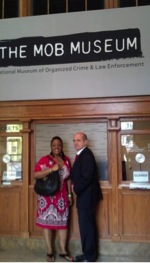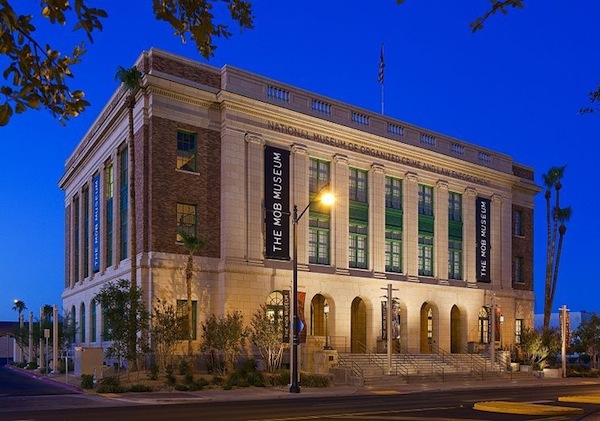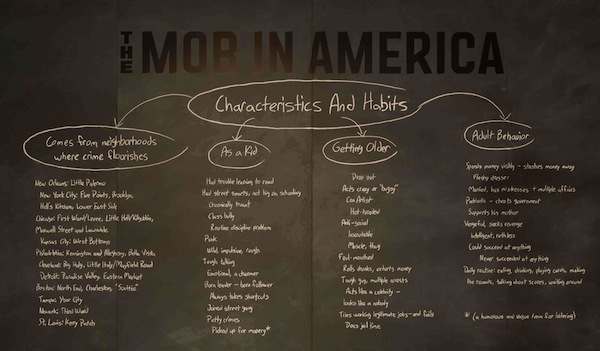I was out in Las Vegas this past May for the SALT Conference. When the cab driver picked up me and my colleague Deidre at the airport, I immediately felt an affinity for him -- he was, after all, the owner of his own small business. I asked him where Deidre and I should go during our free time -- I love museums, but I prefer the off-the-beaten path places you learn about from locals like him.

Steve and Deidre at the Museum
At his suggestion, we visited The Mob Museum, the National Museum of Organized Crime and Law Enforcement in downtown Vegas. Its an institution that gives a voice to both sides of this story -- that of organized crime and the police; and that of the individuals that were victimized by this battle in so many different ways. The voices that I was most fascinated by were those at-risk youth who would become the muscle of the mob -- not unlike the at-risk teenagers who are sucked up by the drug industry. Could we not have prevented the proliferation of youth joining the Mafia through entrepreneurial education?

The Mob Museum's historic building (Photo credit: the Mob Museum)
As a proud Italian American, I have long been fascinated by the archetype of the Italian American mobster -- these were the only Italian Americans represented in media and popular culture at a time when I felt culturally isolated from other Italian Americans -- and the history of organized crime in this country. The mob, aka the Mafia or La Cosa Nostra, was once a seemingly 'untouchable' organized criminal network, known for violent crimes, secret rituals and notorious characters like Al Capone, Bugs Moran, Meyer Lansky, Charlie "Lucky" Luciano, and John Gotti, all of whom have become engraved in popular culture.
Like many others, I am an avid fan of mob or gangster movies, ranging from the beginning of the genre in the early 1930s until today. Some of my favorites include Donnie Brasco, The Godfather Trilogy, the Untouchables, Casino, Carlito's Way,Scarface, and Goodfellas. All of these films feature an Italian or Italian-American male hero, who is ultimately a corrupt, but powerful character in our society. In these films, I see some of the great artistic expression of American cinema, but I also recognize that these archetypes are poor role models. What can we learn from these films? What do they say about the tragedies caused by organized crime? What do they tell us about the lives of those young men recruited to manage and sustain organized crime?
The Mob Museum answers these questions through a brilliantly thorough permanent exhibition of the mob's history, including the characters and communities central to this story. The Museum is in one of Las Vegas's most beautiful historic buildings, the former courthouse and post office built in 1933. I was amazed to see the physical artifacts of this history: a brick wall from the 1929 Chicago massacre; the courtroom recreated from the U.S. Senate's investigation of the mob; and even an old barber chair where a famous mobster was murdered.
It is one of the most well-organized, well-thought-out museums that I have ever visited. Our tour began on the third floor which exhibits the history of the mob: from its inception, the mob preyed on working class people to carry out duties or provide services that had been banned by the Italian, and later the American, government. From the beginning, their main business was prostitution, gambling, and drugs; but the mob really grew in 1920 when the U.S. government prohibited alcohol. When something like the production and selling of alcohol is banned, these activities naturally go underground -- there is still a demand that can be met, and money to be made, but without regulation from the government. In this way, the mobsters became their own regulators, enforcing contracts and punishing crimes in their own way -- with the worst, most disturbed people rising to the top of the mob hierarchy.
Having been an at-risk educator for low-income high school students for 32 years, I have always been fascinated by the relationship between today's at-risk kids, who are going into the drug industry, and those Italian-American boys who were seduced into mafioso careers, many ending up tortured, in prison, and murdered. This juxtaposition struck me as we walked through the Museum's second floor, to a strikingly insightful representation of the characteristics and habits of a gangster -- from childhood on to mature adulthood. As you can see from the photo, these are the very same of at-risk youth today. I knew then, that to teach those future mobsters about entrepreneurship would have saved them from those gruesome fates. Rather than the emblem of the savvy gangster parading stolen gold, we would have had an even more beautiful history of Italian American entrepreneurs, operating the small businesses on which our country was built. Perhaps the lesson here is to persuade today's at-risk youth away from the anguish and peril so brilliantly displayed by the Mob Museum.

Characteristics of a future mobster (Photo credit: the Mob Museum)
